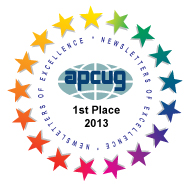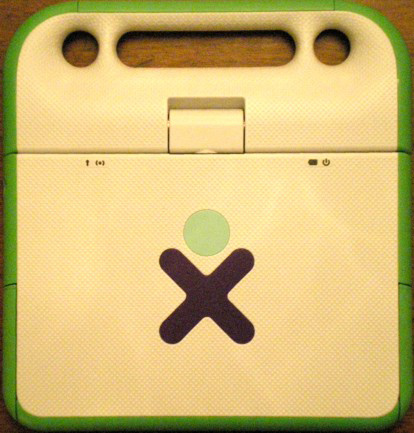 How Come Kids Get All The Good Stuff?
How Come Kids Get All The Good Stuff?
by Jan Fagerholm, OLPC Oligarch
The Bullet Points: The One Laptop Per Child (OLPC) project OX computer is a low cost laptop intended for use by children in emerging societies. It is a project of the MIT Media Laboratory using custom designed hardware and software designed to be both appealing to kids and durable enough to withstand their typical use/abuse. It comes in several colors, features a 7.5” color LCD pivoting display, sound, Web cam, ad-hoc wireless networking, 3 USB ports, an AMD Geode 433 MHz CPU, 256 MB DDR DRAM, a 1024 MB SLC NAND flash hard drive, and a SDRAM slot for expansion. It has a Linux based operating system complete with applications. It is 9”w x 9.5”l x 1.25”h and weighs 3 lbs. with the battery. Battery charging options include a AC power brick, a yo-yo style hand-held flywheel charger, and a hand-crank operated hand held generator.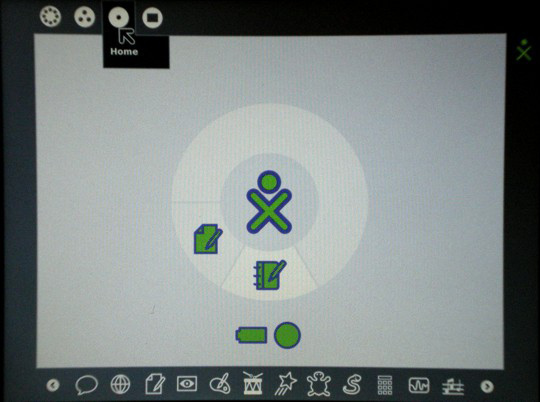
What’s In The Box: (U.S. version) OX laptop, 6.5V Li/Fe battery, AC power adapter, quick start sheet.
The Review: One Laptop Per Child is here! After many changes to take advantage of evolving technology, the OLPC laptop has arrived. Known formally as OX (presumably after the project’s icon), the diminutive device has matured to a point that it is finally being released. While the device is ostensibly aimed at the 6 - 12 year old child, it has many advanced features that assure its suitability for those well beyond that age range.
Originally, the project was characterized as “the $100 laptop project”, but with peripheral technology getting downright cheap, many features were added to the project to expand its appeal and improve its usability. The final product is a complete multimedia machine in addition to its basic function as a classroom computer. Now, it goes out the door for $200.
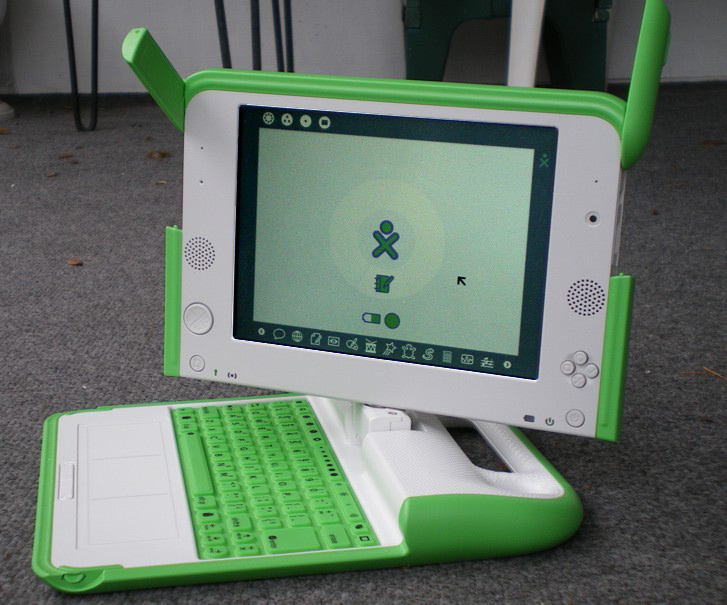 The OLPC project was begun by Nicholas Negroponte in the MIT Media Laboratory. Starting with Seymour Papert’s premise that “learning learning” is the root educational experience, the MIT Media Laboratory set out to rethink the computer with the child’s learning experience in mind. The result is recognized by any experienced computerist, but more important, it is approachable by those with no computer experience, such as children (and maybe my mother). OLPC is now a non-profit project headed by Nicholas Negroponte and counts among its sponsers AMD, Google, Red Hat, and Quanta Computer Inc.
The OLPC project was begun by Nicholas Negroponte in the MIT Media Laboratory. Starting with Seymour Papert’s premise that “learning learning” is the root educational experience, the MIT Media Laboratory set out to rethink the computer with the child’s learning experience in mind. The result is recognized by any experienced computerist, but more important, it is approachable by those with no computer experience, such as children (and maybe my mother). OLPC is now a non-profit project headed by Nicholas Negroponte and counts among its sponsers AMD, Google, Red Hat, and Quanta Computer Inc.
Technical features show clever application of existing technology. The color 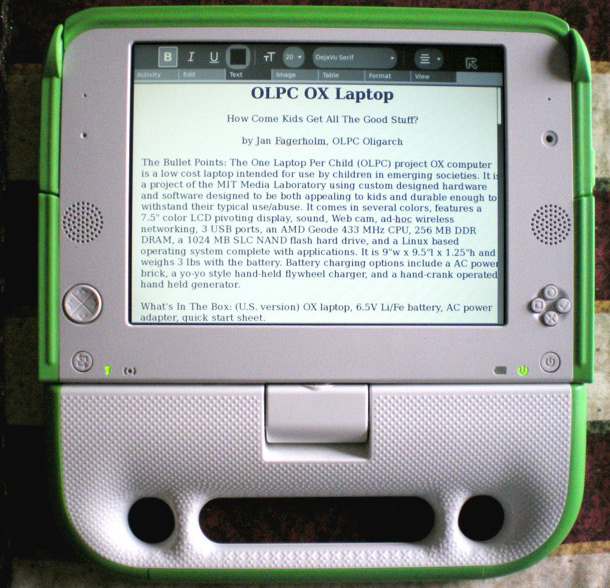 LCD TFT screen is small (7”) but has a 1200x900 pixel resolution. It was designed to be readable outdoors, and I find that it is better than my regular laptop, my camera, and my mobile phone at coping with direct sunlight. The small size is compensated for by keyboard zoom controls, which zoom in and out on anything that is on the screen. The display raises clamshell style like a normal laptop, and also pivots and lays flat over the keyboard tablet PC style. What’s on the screen can be rotated to portrait or landscape mode in all four directions. There are several controls on the frame to control on-screen functions when the display is in tablet position. One of these is a scroll pad which functions like a wheel mouse and is particularly handy for scrolling Web pages and text documents.
LCD TFT screen is small (7”) but has a 1200x900 pixel resolution. It was designed to be readable outdoors, and I find that it is better than my regular laptop, my camera, and my mobile phone at coping with direct sunlight. The small size is compensated for by keyboard zoom controls, which zoom in and out on anything that is on the screen. The display raises clamshell style like a normal laptop, and also pivots and lays flat over the keyboard tablet PC style. What’s on the screen can be rotated to portrait or landscape mode in all four directions. There are several controls on the frame to control on-screen functions when the display is in tablet position. One of these is a scroll pad which functions like a wheel mouse and is particularly handy for scrolling Web pages and text documents.
The device itself is diminutive, and this is shows in the keyboard more than anywhere else; it’s 3/4 scale. It’s rubberized to keep stuff out. In place of the function keys, there are keys dedicated to control and navigation tasks, similar to PC multimedia keyboards. Key spacing is adequate to prevent striking two keys at once with my medium sized hands, but it doesn’t lend itself to touch typing. It probably works well for the hands of its intended audience. I’m using it right now to write this article, and it’s OK for big people, too.
Being a deep-dish Linux geek, I have followed the software development with great interest. The OS is called Sugar. (What, you thought they were going to attract kids with “Asparagus”?) It is based on Fedora 7 running X server, but the desktop is completely original. The objective is a fresh approach to interface design, and it is interesting and clever. I won’t try to detail it much here; see the pictures. It’s completely icon-driven, as befits a younger and international audience, and there are tooltips that are localized for language. The word processor is AbiWord, the Web browser is Firefox, though you will not recognize them: the front end is completely Sugar. There is a common and simple interface to all the Activities for cohesiveness. If you’re curious, you can download the OS and run it with an emulator such as VMWare. Before receiving the OX machine, I gave several demonstrations of the desktop on a PC laptop running Linux and Qemu.
Networking is wireless and automatic, using 802.11b/g, and the recent 802.11s standard for mesh networking. Of the four primary screen views, two of them are views of group activities. Neighborhood is a graphical view of all OX machines and other wireless devices within range. Each OX machine is identified by its individually colored icon, and tooltip with the machine’s name. Group is a view of all OX machines that are collaborating on a single Activity hosted by you, with participating OX icons clustered around it. The Home view shows your icon, with open Activities ringed around it. Home view is the path to functions such as starting and stopping Activities and shutting down or restarting the machine. The remaining view, Activity, is the full screen view of open Activties.
Space considerations prevent complete descriptions of all the included Activities, but here’s a thumbnail: Write, Browse (Web), Paint, TamTamJam music composer (think Apple’s Garage Band), News Reader (RSS feed), Calculate, eToys (guess), and several others of varying utility and entertainment. There are an additional 200 or so activities available from laptop.org’s Wiki: you can download and install them.
One of the adjustments that the computer-brained individual has to make is adjusting to the OX’s method of handling documents. Documents are automatically kept when you exit an Activity or when you shut the machine down. There is a Journal in Home view that automatically tracks everything you do: it is where you go to resume an Activity that was previously saved. This goes a long way to removing the rule-bound use of computers that us adults have had to learn over the years, and that make no sense to kids: the computer simply keeps track of everything and lets you focus on your work/play.
With inexpensive notebook PCs slipping into the market, you may well ask: why bother with the OX when you can get a PC 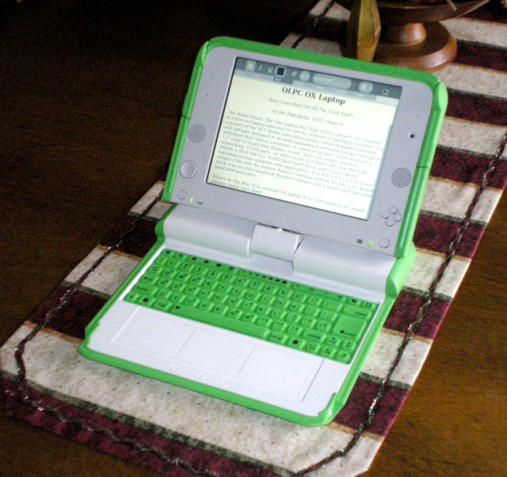 notebook for less than $300? Two trains of thought: 1) the OX is a dustproof, rainproof, and pretty much drop-proof ruggedized computer that comes complete with wireless, video, built-in multimedia and a complete set of software applications. 2) the $300 PC notebook is the starting point; add software costs that probably exceed the price of the hardware, and you still haven’t come up to the functionality of the OX.
notebook for less than $300? Two trains of thought: 1) the OX is a dustproof, rainproof, and pretty much drop-proof ruggedized computer that comes complete with wireless, video, built-in multimedia and a complete set of software applications. 2) the $300 PC notebook is the starting point; add software costs that probably exceed the price of the hardware, and you still haven’t come up to the functionality of the OX.
Bottom line? The OX is simply one of the greatest mind toys you can get your hands on. “Intuitive” is a word that has been ruined by association with clumsy computer software, but the OX restores the word to its original meaning. The OX doesn’t come with a manual because it genuinely doesn’t need one. Its appeal is immediate and sustaining; this thing is a kid magnet (including oversized kids like me). By the time you read this, the Give One Get One purchase program will be over, but the OX will become more readily available through normal channels. Get one. Pretend that it’s for the kids and enjoy it yourself. Highly recommended.
Product Information
OX Laptop
Price: $200
One Laptop Per Child
http://laptop.org




